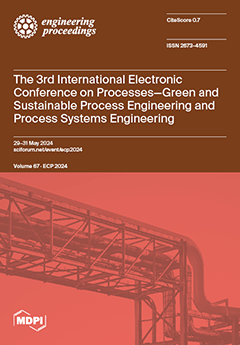The efficacy of spray dry systems compared to wet flue gas desulphurisation (FGD) units depends on applying a highly reactive scrubbing reagent. This study assessed sodium-based compounds derived from natural sources and waste by-products as potential agents for treating sulphur dioxide (SO
2). Sodium carbonate (Na
2CO
3) and sodium bicarbonate (NaHCO
3) were acquired from mineral deposits, whereas the black ash waste (Na
2CO
3·NaHCO
3) was obtained from the pulp and paper sector. The sorbents introduced in slurry form were subject to SO
2 absorption conditions in a lab-scale spray dryer, including an inlet gas phase temperature of 120–180 °C, flue gas flow rate of 21–34 m
3/h, and sodium to sulphur normalised stoichiometric ratio (Na:S) of 0.25–1. The comparative performance was evaluated using the metric of %SO
2 (
) removal efficiency. The results showed that NaHCO
3 had the highest overall result, with a removal efficiency of 62% at saturation. Black ash was the second best-performing reagent, with a 56% removal efficiency, while Na
2CO
3 had the lowest efficiency (53%). The maximum degree of SO
2 reduction achieved using NaHCO
3 under specific operating parameters was at an NSR of 0.875 (69%), a reaction temperature of 120 °C (73%), and a gas inlet flow rate of 34 m
3/h. In conclusion, the sodium reagents produced significant SO
2 neutralisation, exceeding 50% in their unprocessed state, which is within acceptable limits in small- to medium-sized coal-fired power plants considering retrofitting pollution control systems.
Full article




